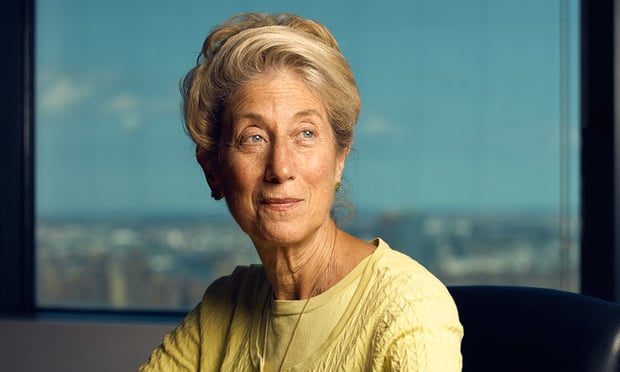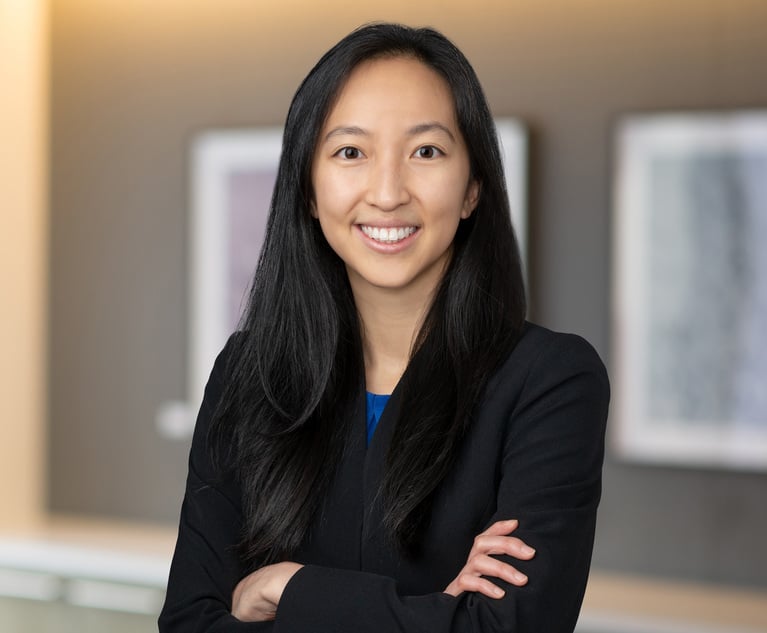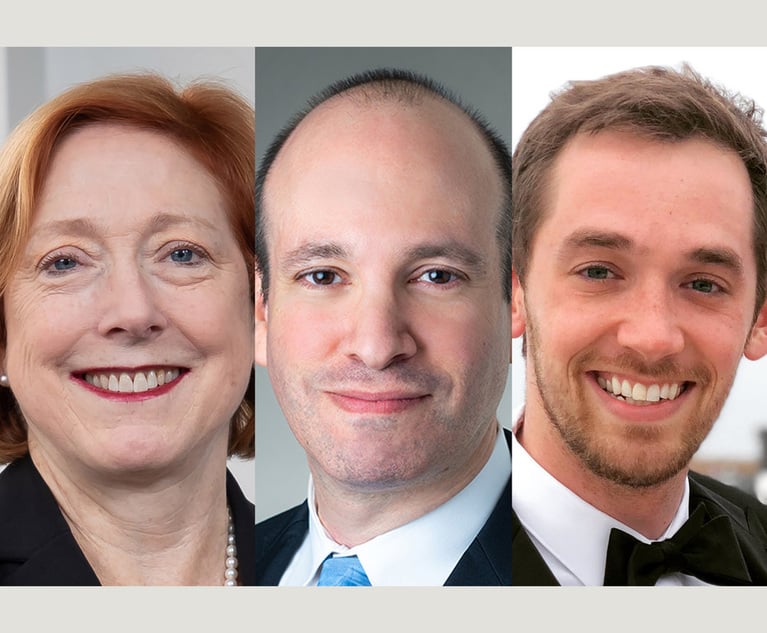New Study Shows Only Slight Improvement in Women's Representation in NY Courtrooms
NYSBA President Henry "Hank" Greenberg called the lack of change "unacceptable and disturbing," emphasizing that the 2017 report included concrete steps that law firms, clients and judges could take to improve matters.
May 28, 2020 at 05:39 PM
5 minute read
The original version of this story was published on New York Law Journal
 Shira Scheindlin, retired U.S. District judge for the Southern District of New York.
Shira Scheindlin, retired U.S. District judge for the Southern District of New York.
Three years after a New York State Bar Association study raised the alarm about under-representation of female attorneys in courtrooms, progress has been incremental, according to a new study released Thursday.
The study, which is based on questionnaires from state and federal judges across New York who documented the gender of lawyers who spoke and appeared before them during a four-month period, found that 25.3% of attorneys in lead counsel roles in 2020 were women, compared with 24.7% in 2017.
NYSBA President Henry "Hank" Greenberg called the lack of change "unacceptable and disturbing," emphasizing that the 2017 report included concrete steps that law firms, clients and judges could take to improve matters.
Many of the 2017 recommendations were aimed at ensuring women have more chances to speak during depositions and trials, and the earlier study noted that junior female attorneys working in the public sector tended to have more opportunities to practice hands-on skills early in their careers.
The percentage of female lead attorneys in the public sector actually declined from 2017 to 2020, according to the new study, but it remained significantly higher than the number of female lead attorneys in the private sector.
In 2020, 35.1% of public-sector lead attorneys were women compared with 20.8% in the private sector, while the 2017 study found that 38.2% of public-sector lead attorneys were women compared with 19.4% in the private sector.
Members of the NYSBA's Commercial & Federal Litigation Section Task Force on Women's Initiatives wrote both reports. Retired U.S. District Judge Shira Scheindlin, of counsel to Stroock & Stroock & Lavan and the principal author of the updated report, said now is the time to implement the group's recommendations.
Carrie H. Cohen, a partner at Morrison & Foerster and a co-author of the report, said she hopes the 2020 report is viewed as a call to action.
"It is critical during this unprecedented public health pandemic that we double-down and increase focus on diversity efforts to ensure that the limited progress that has been made for women and minority attorneys is not lost, especially as women and diverse attorneys too often are disproportionately impacted by crises," she said.
The report found that some suggestions from the 2017 report have been successfully implemented. Many more judges have changed their individual rules of practice to encourage participation by younger and more diverse attorneys, the report noted, and in-house legal departments are focusing more on diversity when they hire outside counsel.
More law firms have built up their women's initiatives since 2017, the report found, but the task force recommended a number of improvements at firms, including more sponsorship of women by male and female senior attorneys and more credit for traditionally nonbillable work.
Sponsorship and other diversity and inclusion efforts should be included in compensation calculations to incentivize firms' long-term prospects, the task force wrote.
Firms also need to examine how and to whom senior male attorneys pass their books of business as they move toward retirement, the task force wrote, noting that firms often allow senior attorneys to maintain "ownership" of clients even after they've stopped doing day-to-day work for that client.
"Given that the Baby Boomer generation is nearing retirement, the lack of succession planning is critical to the future of the firm," they wrote. "Nonetheless, such planning, if it exists, appears to be mostly subjective and lacking in transparency."
Because so many top rainmakers are men, the task force wrote, they must "conscientiously include women in their business opportunities."
Other findings from the 2020 study included:
• Overall appearances by women in the New York courts improved slightly more than the lead counsel count since 2017. Women made up 26.7% of attorneys appearing in civil and criminal cases, which is a 1.5 percentage point increase from 2017. • The share of women appearing as additional counsel increased 9 percentage points compared with 2017, to 36.4%. • In cases with multiple parties per side, women's participation increased compared with 2017 but remained much lower than cases with just one party per side, indicating that gender diversity in complex cases is an ongoing issue. • Compared with 2017, women's participation in trial courts increased more than their participation in appellate courts. In 2020, women made up 26.3% of appearances in trial courts and 24.7% of appearances in appellate courts. • Upstate courts had more participation by women than downstate courts, with women appearing in lead roles 27.9% of the time compared with 24.2% of the time downstate. • With the caveat that federal criminal cases were included in the study while state criminal cases, where many public-sector attorneys practice, were not surveyed, federal courts were found to have more participation by women than the state trial courts' commercial divisions. Lead attorneys were female 35.1% of the time in the Commercial Division of the Eighth Judicial District in Erie County and 31.8% of the time in the Southern District of New York. The lowest rate of appearances by women was in the Commercial Division of New York County, with 18.7%.
Read more:
Courtroom Study Finds Women Lawyers Eclipsed in Complex Cases
General Counsel Should Be Asking How Origination Credit is Awarded
Are Gender Pay Gaps Worse for General Counsel at the Largest Corporate Legal Departments?
This content has been archived. It is available through our partners, LexisNexis® and Bloomberg Law.
To view this content, please continue to their sites.
Not a Lexis Subscriber?
Subscribe Now
Not a Bloomberg Law Subscriber?
Subscribe Now
NOT FOR REPRINT
© 2025 ALM Global, LLC, All Rights Reserved. Request academic re-use from www.copyright.com. All other uses, submit a request to [email protected]. For more information visit Asset & Logo Licensing.
You Might Like
View All
MoFo Associate Sees a Familiar Face During Her First Appellate Argument: Justice Breyer

Amid the Tragedy of the L.A. Fires, a Lesson on the Value of Good Neighbors

Litigators of the Week: Shortly After Name Partner Kathleen Sullivan’s Retirement, Quinn Emanuel Scores Appellate Win for Vimeo
Law Firms Mentioned
Trending Stories
- 1Decision of the Day: Judge Dismisses Defamation Suit by New York Philharmonic Oboist Accused of Sexual Misconduct
- 2California Court Denies Apple's Motion to Strike Allegations in Gender Bias Class Action
- 3US DOJ Threatens to Prosecute Local Officials Who Don't Aid Immigration Enforcement
- 4Kirkland Is Entering a New Market. Will Its Rates Get a Warm Welcome?
- 5African Law Firm Investigated Over ‘AI-Generated’ Case References
Who Got The Work
J. Brugh Lower of Gibbons has entered an appearance for industrial equipment supplier Devco Corporation in a pending trademark infringement lawsuit. The suit, accusing the defendant of selling knock-off Graco products, was filed Dec. 18 in New Jersey District Court by Rivkin Radler on behalf of Graco Inc. and Graco Minnesota. The case, assigned to U.S. District Judge Zahid N. Quraishi, is 3:24-cv-11294, Graco Inc. et al v. Devco Corporation.
Who Got The Work
Rebecca Maller-Stein and Kent A. Yalowitz of Arnold & Porter Kaye Scholer have entered their appearances for Hanaco Venture Capital and its executives, Lior Prosor and David Frankel, in a pending securities lawsuit. The action, filed on Dec. 24 in New York Southern District Court by Zell, Aron & Co. on behalf of Goldeneye Advisors, accuses the defendants of negligently and fraudulently managing the plaintiff's $1 million investment. The case, assigned to U.S. District Judge Vernon S. Broderick, is 1:24-cv-09918, Goldeneye Advisors, LLC v. Hanaco Venture Capital, Ltd. et al.
Who Got The Work
Attorneys from A&O Shearman has stepped in as defense counsel for Toronto-Dominion Bank and other defendants in a pending securities class action. The suit, filed Dec. 11 in New York Southern District Court by Bleichmar Fonti & Auld, accuses the defendants of concealing the bank's 'pervasive' deficiencies in regards to its compliance with the Bank Secrecy Act and the quality of its anti-money laundering controls. The case, assigned to U.S. District Judge Arun Subramanian, is 1:24-cv-09445, Gonzalez v. The Toronto-Dominion Bank et al.
Who Got The Work
Crown Castle International, a Pennsylvania company providing shared communications infrastructure, has turned to Luke D. Wolf of Gordon Rees Scully Mansukhani to fend off a pending breach-of-contract lawsuit. The court action, filed Nov. 25 in Michigan Eastern District Court by Hooper Hathaway PC on behalf of The Town Residences LLC, accuses Crown Castle of failing to transfer approximately $30,000 in utility payments from T-Mobile in breach of a roof-top lease and assignment agreement. The case, assigned to U.S. District Judge Susan K. Declercq, is 2:24-cv-13131, The Town Residences LLC v. T-Mobile US, Inc. et al.
Who Got The Work
Wilfred P. Coronato and Daniel M. Schwartz of McCarter & English have stepped in as defense counsel to Electrolux Home Products Inc. in a pending product liability lawsuit. The court action, filed Nov. 26 in New York Eastern District Court by Poulos Lopiccolo PC and Nagel Rice LLP on behalf of David Stern, alleges that the defendant's refrigerators’ drawers and shelving repeatedly break and fall apart within months after purchase. The case, assigned to U.S. District Judge Joan M. Azrack, is 2:24-cv-08204, Stern v. Electrolux Home Products, Inc.
Featured Firms
Law Offices of Gary Martin Hays & Associates, P.C.
(470) 294-1674
Law Offices of Mark E. Salomone
(857) 444-6468
Smith & Hassler
(713) 739-1250







